ENG
Mosques In China
Guilin
Lanzhou Water Mosque
Address: Jinchengguan Road, Lanzhou, Gansu Province, China
The Water Mosque was built in the year of 1952, Lanzhou Water Mosque is one of the most famous mosques in Lanzhou, it was previously well-known as Kuluwan Mosque, is situated on the southern bank of Yellow River and is next to White Pagoda Mountain on the north side. Taking a broad view of the mosque from the New Yellow River Bridge, you will find that it looks like an exquisite jade straightly standing in the Yellow River.
The mosque is built in Arabic architectural style with a prayer room covering an area about 488 square meters on the second floor. With the interior walls in faint yellow and olive green, sufficient sunshine inside, you will get a chance to appreciate the solemn and awe-inspiring atmosphere there. Going outside of the mosque, you will be able to admire the amazing oil painting featured with the beauty of oriental. The dome of the prayer hall is furnished with colorful lamp bulbs, which will give you a more glistening evening. The mosque is well-equipped for the local Muslims to pray and other activities.
The mosque is built in Arabic architectural style with a prayer room covering an area about 488 square meters on the second floor. With the interior walls in faint yellow and olive green, sufficient sunshine inside, you will get a chance to appreciate the solemn and awe-inspiring atmosphere there. Going outside of the mosque, you will be able to admire the amazing oil painting featured with the beauty of oriental. The dome of the prayer hall is furnished with colorful lamp bulbs, which will give you a more glistening evening. The mosque is well-equipped for the local Muslims to pray and other activities.
Qiaomen Mosque
Address: No.275 Zhongshan Road, Qiaomen Building, Lanzhou
Qiaomen Mosque is located in Lanzhou’s Muslim district Qiaomen Alley and is one of Lanzhou’s earliest six mosques located on Zhongshan Road. As early as the Ming Dynasty, there was a small mosque in Qiaomen Alley.
During the reign of Qing Emperor, Kangxi. Liu Boyang, a local Muslim, donated 5,333 square meters land to expand the mosque. He worked hard with his son Liu Jizong, along with dedicated local Muslims the mosque was gradually expanded.
Lanzhou Xiguan Mosque
Address: Baiyin Road, Shixia District, Lanzhou
Xiguan Mosque was originally built during the Wanli Emperor of the Ming Dynasty. During the Qing Dynasty, the mosque underwent two big reconstructions. The mosque was rebuilt in 1990 into what it is today with the added dome.
The style of the mosque follows the Arabic Islamic style, while the prayer hall combines the Chinese classical and Arabic architectural style. The mosque covers an area of 467 m2 with its prayer hall spans over 141 m2.
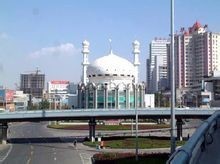
Jinniu Street Mosque
Address: No. 41, Jinniu Street, Panlong District, Kunming
Jinniu Street Mosque was constructed by Hui Ethnic group during Yuan Dynasty (1271-1368), and it was rebuilt and enlarged for several times. The prayer hall is a combined by wood and concrete, and it can hold 200 people to pray at the same time. This mosque is the only one well preserved Chinese architectural style mosque in Yunnan Province.
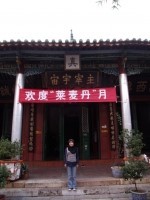
Kunming Yixigong Mosque
Address: No. 4, Nanchang Street, Wuhua District, Kunming
The Yixigong Mosque was completed in the year of 1898. It is located at center of Kunming City, and it attracts numerous numbers of Muslim come here look for inner peace.

Shuncheng Street Mosque
Address: Dunren Xiang, Shuncheng Street, Kunming
Kunming Shuncheng Street Mosque is one of the most famous mosques in China, and the Islamic Association of Yunnan Province also located here. It was built in the year of 1425 during Ming Dynasty(1368-1644) and was rebuilt and enlarged many times during Qing Dynasty(1644-1911).
The current mosque covers an area of 10,000 square meters, including the prayer hall, wudu area, offices, wing-rooms, rest area, dining hall and other facilities.
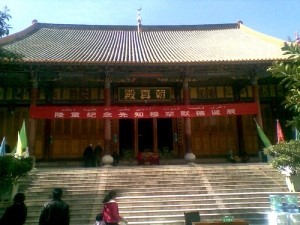
Kunming Chongde Mosque
Address: Dongsi Street, Wuhua District, Kunming
Chongde Mosque is in a five-floor Arabic-style building, which covers an area of 2,500 square meters, it is a new type of design and has become an attraction in Kunming.
The mosque starts from the third floor, the female prayer hall is on the fourth floor, and male prayer hall is on the fifth floor. Besides, there is a garden on the roof top.

Kunming Yongning Mosque
Address: No. 153, Jinbi Road, Kunming
Yongning Mosque was built in Yuan Dynasty(1271-1368). The current building left was rebuilt in the year of 1898. The layout of the mosque is a quadrangle courtyard. Entering the gate is a spacious yard.
The prayer hall covers an area of 200 square meters. In front of the hall is the Juanpeng-style porch. Opposite the hall are the wing-rooms, which serve as the rest room for people after they prayed. In the sides of the hall are the meeting room and class room.

Kunming Nancheng Mosque
Address: No. 18, Zhengyi Road, Kunming
Nancheng Mosque is the largest mosque in Kunming. It was built in Tang Dynasty (618-907) and was rebuilt many times during Qing Dynasty(1644-1911). The architectural style is traditional Chinese style. The current existing buildings was rebuilt in 1996, which covers an area of 2,557 square meters. The major constructions are the Chaozhen hall, and Xuanli tower.
The Chaozhen hall is a three-floor building, covering an area of 1,200 square meters. In front of the hall is the courtyard. Both south and north side of the courtyard are the wing-rooms. The east of the courtyard is a nine-floor Muslim building, which covers an area of 5,800 square meters. The Xuanli tower is 9 meters high. The mosque also keeps various number of books.
The Chaozhen hall is a three-floor building, covering an area of 1,200 square meters. In front of the hall is the courtyard. Both south and north side of the courtyard are the wing-rooms. The east of the courtyard is a nine-floor Muslim building, which covers an area of 5,800 square meters. The Xuanli tower is 9 meters high. The mosque also keeps various number of books.
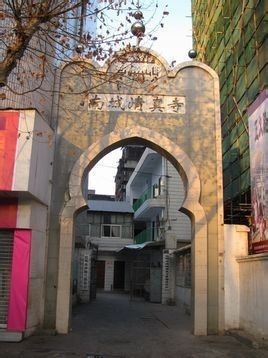
Jinan South Mosque
Address: Lipaisi Street, Shizhong District, Jinan
The Jinan Great Southern Mosque is the oldest mosque in the city of Jinan, Shandong Province, China. It was established during the Yuan dynasty (in 1295). Most of the present structures were erected during the Ming dynasty (in 1436 and 1492).
The basic layout of the mosque is that of a Chinese temple into which the elements needed for its function as a mosque have been integrated. According to legend, the Great Southern Mosque was founded during the Tang dynasty, but there are no known records to confirm this. The written record dates the establishment of the mosque at its present site to the year 1295, during the first year of the reign of Temür Khan (Emperor Chengzong of Yuan).
Construction of the present day structures started in the 1420s and 1430s. Significant extpansions were undertaken in the year 1492, the fifth year in the reign of the Hongzhi Emperor. Other recorded renovations followed during the reigns of the Jiajing (1521–1567) and Wanli (1572–1620) Emperors of the Ming dynasty, the Jiaqing (1796–1820), Daoguang (1820–1850), and Tongzhi (1861–1875) Emperors of the Qing dynasty, as well as during the early Republican era.
The mosque was damaged severely during the Cultural Revolution with many of the historical artifacts it housed being destroyed and the building converted into a factory. Since 1992, it has been protected as a provincial-level key cultural heritage site.
The basic layout of the mosque follows the courtyard style of a traditional Chinese temple with major buildings arranged along a main axis of symmetry. However, whereas in a Chinese temple, this main axis is typically oriented in the north-south direction, the main axis of the Great Southern Mosque is oriented in the east-west direction so that upon entering the main prayer hall one faces west (towards Mecca). In keeping with Chinese tradition, the main entrance of the mosque is protected by a spirit wall.
In total, the mosque covers an area of 6,630 square meters of which 2,830 square meters are covered by buildings.
The basic layout of the mosque is that of a Chinese temple into which the elements needed for its function as a mosque have been integrated. According to legend, the Great Southern Mosque was founded during the Tang dynasty, but there are no known records to confirm this. The written record dates the establishment of the mosque at its present site to the year 1295, during the first year of the reign of Temür Khan (Emperor Chengzong of Yuan).
Construction of the present day structures started in the 1420s and 1430s. Significant extpansions were undertaken in the year 1492, the fifth year in the reign of the Hongzhi Emperor. Other recorded renovations followed during the reigns of the Jiajing (1521–1567) and Wanli (1572–1620) Emperors of the Ming dynasty, the Jiaqing (1796–1820), Daoguang (1820–1850), and Tongzhi (1861–1875) Emperors of the Qing dynasty, as well as during the early Republican era.
The mosque was damaged severely during the Cultural Revolution with many of the historical artifacts it housed being destroyed and the building converted into a factory. Since 1992, it has been protected as a provincial-level key cultural heritage site.
The basic layout of the mosque follows the courtyard style of a traditional Chinese temple with major buildings arranged along a main axis of symmetry. However, whereas in a Chinese temple, this main axis is typically oriented in the north-south direction, the main axis of the Great Southern Mosque is oriented in the east-west direction so that upon entering the main prayer hall one faces west (towards Mecca). In keeping with Chinese tradition, the main entrance of the mosque is protected by a spirit wall.
In total, the mosque covers an area of 6,630 square meters of which 2,830 square meters are covered by buildings.
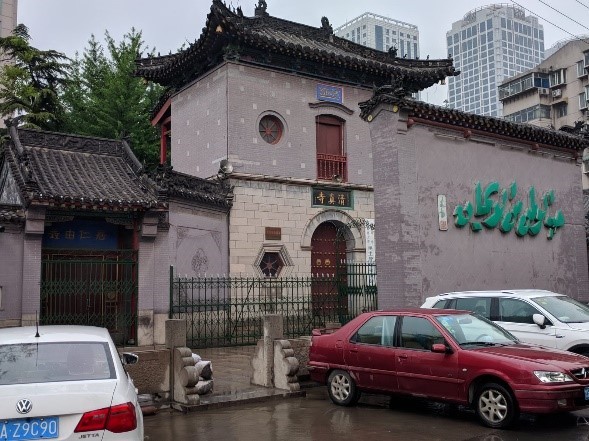
Hohhot Great Mosque
Address: Kuanxiangzi, Huimin District, Hohhot
The Great Mosque of Hohhot is a mosque in Huimin District, Hohhot, Inner Mongolia, China. It is the oldest and largest mosque in Inner Mongolia. The mosque was constructed in 1693 by the Hui people. It was then renovated in 1789 and 1923.
The mosque was designed with the Chinese and Arabic architecture and built with black bricks. It covers an area of 4,000 m2. It has one minaret with a height of 15 meters and a public bath.
The mosque was designed with the Chinese and Arabic architecture and built with black bricks. It covers an area of 4,000 m2. It has one minaret with a height of 15 meters and a public bath.
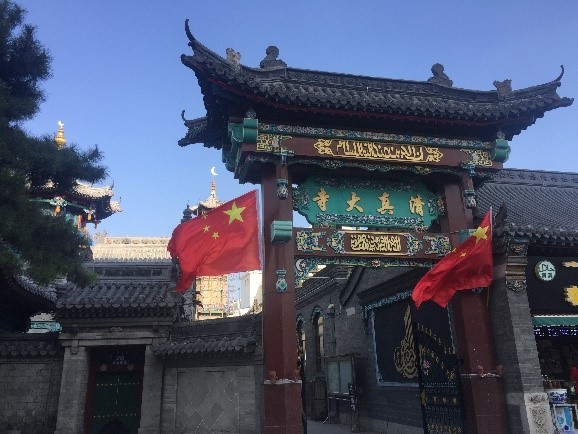
Hefei Mosque
Address: No. 35, Shouchun Road, Yaohai District, Hefei
The Hefei Mosque was first built in Ming Dynasty(1368-1644). It is a sizable, beautiful and well-structured mosque, it covers an area of 1,500 square meters. The prayer hall is a two-floor Arabic-style building, which occupies an area of 160 square meters.
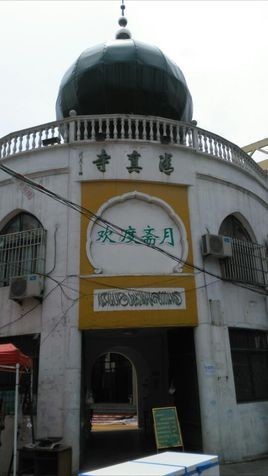
Harbin Xiangfang Mosque
Address: 4, Songshan Rd, Xiangfang Dist, Harbin
Located in Xiangfang District of Harbin City, the Xiangfang Mosque was constructed in 1905. It was once mindlessly defiled by the Red Guards during the period of Cultural Revolution (1966-1976) and was restored to use in 1990.
The mosque covers an area of approximately 1,600 square meter, and with a building area of 225.33 square meter. The major buildings of the mosque include the main hall, bath house and imam room. The prayer hall occupies an area of 87 square meter. It is the largest mosque worship hall in Heilongjiang Province featured with Arab architectural style.
The mosque covers an area of approximately 1,600 square meter, and with a building area of 225.33 square meter. The major buildings of the mosque include the main hall, bath house and imam room. The prayer hall occupies an area of 87 square meter. It is the largest mosque worship hall in Heilongjiang Province featured with Arab architectural style.
Tartar Mosque
Address: No. 108, Tongjiang Street, Daoli District, Harbin, Heilongjiang
Tartar Mosque, also named Turkish Mosque, the mosque is a unique combination of traditional Arabic architecture and Byzantine art, which made the mosque the only one in Northern China in the style.
It was originally built in 1901 by local Tartars ethnic group. The construction area covers 300 square meters, and 30 meters in height.
It was originally built in 1901 by local Tartars ethnic group. The construction area covers 300 square meters, and 30 meters in height.
Hulan Mosque
Address: Lanhe Main Street, Harbin, Heilongjiang Province
Hulan Mosque is located on the bank of Hulan River in Harbin, Heilongjiang Province. It covers an area of 5,000 square meters, and surrounded by blue brick wall. It was originally built in the year of 1810, Qing dynasty. The original structure of the mosque only contains three humble straw houses. Local Hui people later raised fund for the mosque and significant extension was undertaken in the year 1875.
Harbin Yilan Mosque
Address: Yilan District, Harbin
Yilan Mosque covers a total area of 3,560 square meters and has funded by the government for renovations. The mosque currently has an estimated 2,850 worshippers.
Harbin Daowai Mosque
Address: No. 44, Shisandao Street, Daowai District, Harbin
The Daowai Mosque or Harbin Mosque is a mosque in Daowai District, Harbin, Heilongjiang, China. It is the largest mosque in Heilongjiang. The mosque was originally built during the Guangxu Emperor of Qing Dynasty in 1897. Building extension was constructed in 2003. The mosque consists of prayer hall, office and other facilities. Covering an area of 426 m2, the prayer hall is located at the center of the building area which is opposite to the main gate. It can accommodate up to 600 people to perform prayers.
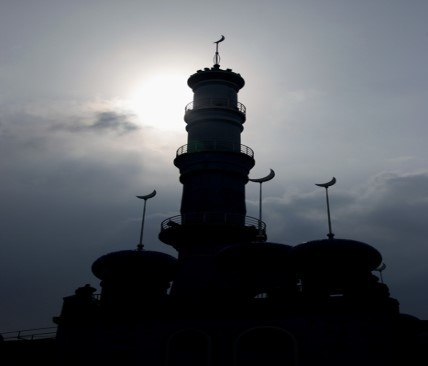
Guiyang Mosque
Address: Xiazhuangyuan Road, Yunyan District, Guiyang
The Guiyang Mosque is the only mosque in Guiyang. It was first built by Hui people in 2nd year(1724) of Yongzheng, Qing Dynasty(1644-1911) and was rebuilt in the 7th year(1837) of Daoguang, Qing Dynasty. The temple covers an area of 630 square meters. The prayer hall is a Chinese traditional building which covers an area of 130 square meters, including the main hall, kiln hall and Juanpeng. In the south of the prayer hall is a five-floor building, which occupies an area of 400 square meters. The office room, teaching room, store room, bath room and guest house are set up in the building.

Guilin Luojin Mosque
Address: Luojin town,Yongfu County, Guilin
The Luojin Masque was first built in the year of 1850, in Qing Dynasty (1644-1911). It stands in wind and rain vicissitudes and has gone through rise and fall. The mosque covers an area of 600 square meters. The prayer hall is constructed with green round arch and reinforced concrete structure. The overall design is symmetrical, towering and solemn.

Guilin Liutang Mosque
Address: Lingui County, Guilin
Liutang Mosque was built in Qianlong, and destroyed in the war. It was rebuilt during Daoguang times in Qing Dynasty. It is a relatively intact large-scale mosque in Guangxi with an area of about 3.7 mu, total construction area 170O square meters, construction area of about 30O square meters hall. The ancient traditional architectural style. The mosque is precise layout, compact structure with plants, seasonal fragrance inside.
